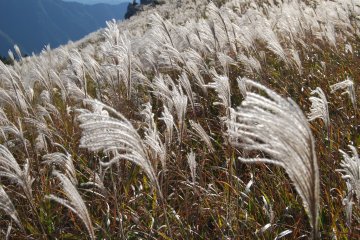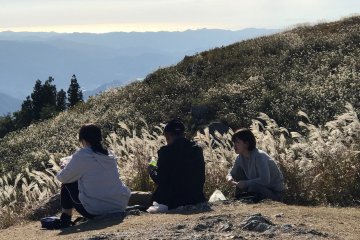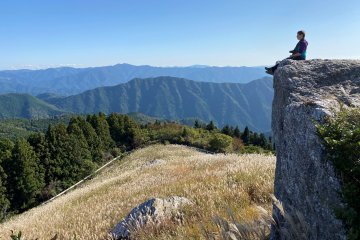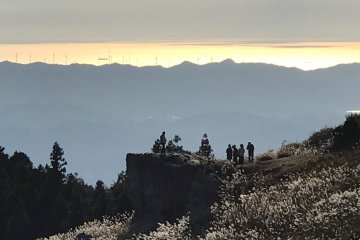I had seen the Sengokuhara pampas grass field in Hakone before but did not expect to find an even larger field of this silver grass just at my doorsteps in the north of Wakayama Prefecture. A late autumn road trip took me to Oishi Kogen, a highland just south of Osaka Prefecture, where a large field of pampas grass awaits visitors. The Oishi Kogen pampas grass is famous in Kansai!
Pampas grass is called susuki in Japanese. Although susuki grows almost everywhere in the Japanese countryside, city-dwellers are known to flock to large fields of susuki in autumn.
Pampas grass is known as one of the "Seven Flowers of Autumn". Did you know that? The other six are: Bush Clover, Kuzu Vine, Morning Glory, Fringed Pink, and Ominaeshi and Fujibakama, for which I don't know the English names.
Well, did you know then that susuki was once used to thatch the roofs of houses? In the area at the base of Oishi Kogen, and in other places in Wakayama Prefecture and nearby Nara Prefecture, one can still see some of the old thatched-roof houses. They have become a rare sight now.

The view of pampas grass in late autumn tells you that winter is coming soon.
At a height of 870 meters lies a large plain of pampas grass (13 hectare), even larger than I had seen before. I think this is the best pampas grass land in the Kansai area. There are some rocky peaks and also some observation platforms from where it is easy to overlook the whole area.
The tall grass, even higher than a human, changes its color from golden around September to silvery-white at the end of October and the middle of November.
One of the rocky spots is very popular for taking photos. If you shoot at the right angle, it looks as if you sit on a very high cliff.

A windy road leads all the way up to the highland. There is a parking lot and a rest area with a small restaurant and souvenir shop. For those who are serious outdoor fans, there is a small campsite with no facilities. So, stock up on your snacks and drinks when you want to watch the night sky over Oishi Kogen, which is also a popular activity.
The trails through the pampas grass are well marked and walkers might enjoy a short hike all the way to the other end of the large field. The lazy ones can just hang around the area near the rest area. Just a few minutes walking from the parking lot and you stand in the middle of the silver grass.
This is perfect for a half-day trip but you can easily make it a whole day out here by just sitting down for a picnic and enjoying the view, then take a walk across the pampas grass field, or even go for a longer hike. There are some long hike options. While it is also possible to come here in spring and in summer, the most scenic season for Oishi Kogen is autumn.
There are panoramic 360-degree views of the area around. You can see all the way to the ocean in the far back and see the wind farms on the hills of Kainan. On a clear day you can even see Mount Rokko, Awaji Island and Shikoku Island.











